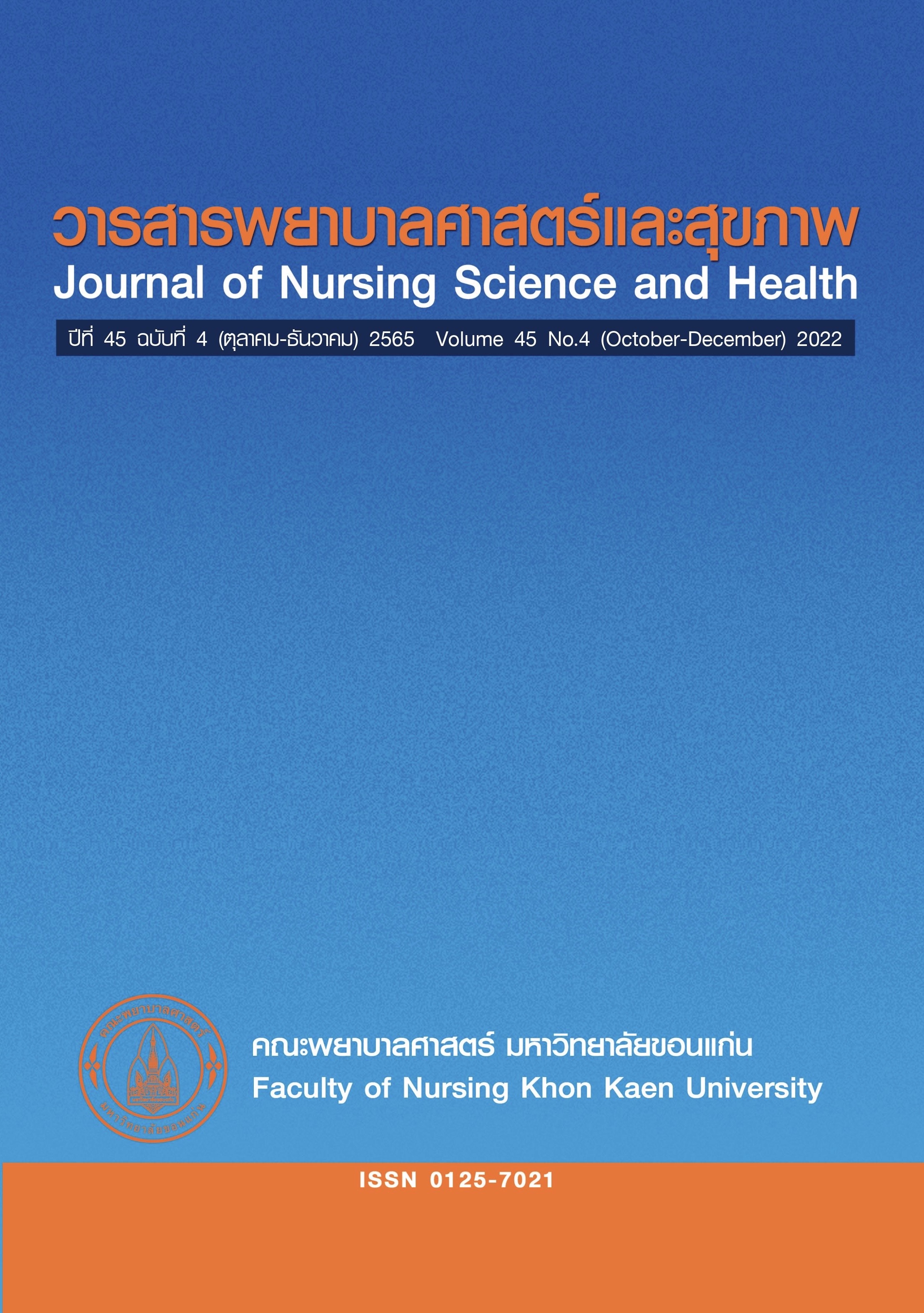เรียนรู้จากครูพยาบาล ณ ลานดอกปีบ: การวิจัยเชิงอัตชาติพันธุ์วรรณนา
คำสำคัญ:
การวิจัยเชิงอัตชาติพันธุ์วรรณนา , คณะพยาบาลศาสตร์ มหาวิทยาลัยขอนแก่น, ครูพยาบาลรุ่นแรก, เรื่องเล่าบทคัดย่อ
การวิจัยเชิงอัตชาติพันธุ์วรรณนาเพื่อวิเคราะห์และตีความจากเรื่องเล่าถึงประสบการณ์ในฐานะเป็นอาจารย์รุ่นบุกเบิกในการก่อร่างสร้างคณะพยาบาลศาสตร์ มหาวิทยาลัยขอนแก่น ซึ่งเป็นคณะวิชาที่ผลิตพยาบาลวิชาชีพที่จัดตั้งในรูปแบบคณะวิชาเป็นแห่งแรกของประเทศไทย โดยเจ้าของประสบการณ์เล่าเรื่องเชิงประวัติการทำงานของตนในการทำงานที่คณะพยาบาลศาสตร์ บันทึกเสียง และถอดการบันทึกเสียงแบบคำต่อคำ จากนั้นนำเอกสารบันทึกมาวิเคราะห์และตีความร่วมกับเอกสารเชิงประวัติศาสตร์อื่น ๆ ที่เกี่ยวข้องเพื่อวิเคราะห์หาความหมายของชีวิตการทำงานที่เป็นการทำความเข้าใจความคิดของผู้เล่าเรื่อง โดยร่วมกันวิเคราะห์ตามมุมมองคนในของผู้เล่าเรื่องและจากมุมมองคนนอกของผู้ร่วมศึกษา ผลการวิเคราะห์ข้อมูลได้แก่นความคิดการรับรู้ตนเองของผู้เล่าเรื่อง ดังนี้ 1) ชีวิตปฐมวัย: ใจสู้ ไม่รู้ถอย 2) วัยประถมถึงมัธยม: ซุกซนคนชายขอบ 3) โชคชะตานำพามาเรียนพยาบาลทั้งที่กลัวผีที่สุด 4) กว่าจะเป็นพยาบาล มข.: เตรียมครูแรกรุ่นสอนรุ่นแรก 5) สร้างห้องเรียนการพยาบาลจากฉากชีวิตจริงและบริบทที่ขาดแคลน 6) พัฒนาการศึกษาตนเอง 7) อาจารย์พยาบาลกับชีวิตการทำงานแบบถวายหัว 8) ปักหมุดหลักสูตรปริญญาโทสาขาวิชาการบริหารการพยาบาล และ 9) ถอดบทเรียน: เขียนข้อห่วงใย
ผลการวิเคราะห์จากเรื่องเล่าและอภิปรายผลร่วมกับความคาดหวังตามคุณลักษณะอาจารย์และผู้บริหารสถาบันการศึกษาในยุคศตวรรษที่ 21 อาจเป็นประโยชน์แก่ผู้สนใจและผู้บริหารจัดการด้านการศึกษาพยาบาลต่อไป
เอกสารอ้างอิง
Wright J. Searching one’s self: The autoethnography of a nurse teacher. J Res Nurs 2008;13(4):338-47.doi: 10.1177/1744987107088046
Peterson AL. A case for the use of autoethnography in nursing research. J Adv Nurs 2015;71(1):226-33. doi: 10.1111/jan.12501
Pariseau-Legault P. From clinical practice to nursing research: Autoethnography as a tool for analyzing the researcher’s identity transitions.
Rech Soins Infirm 2018;135(12):38-47. Available from: https://doi:10.3917/rsi.135.0038
Prabnasak, B. A book on the twenty-year anniversary of the faculty of nursing, Khon Kaen university. Khon Kaen: Siriphaan Offset; 1992, p.10-6. (in Thai)
Denzin NK. Performance autoethnography: Critical pedagogy and the politics of culture. 2nd ed. New York: Routledge;2018.
Anderson L. Analytic autoethnography. J Contemp Ethnogr 2006;35(4):373-95.
Duncan M. Autoethnography: Critical appreciation of an emerging art. Int J Qual Methods 2004;3(4):1-14.
Hughes SA, Penning JL. Autoethnography: Process, product, and possibility for critical socialresearch.ThousandOaks,CA:Sage;2017.
Ellis C, Adams TE, Bochner AP. Autoethnography: An overview. Historical Social Research 2011; 36(4):273-90.
Bishop EC, Shepherd ML. Ethical reflections: Examining reflexivity through the narrative paradigm. Qual Health Res 2011;21(9):1283-94. Available from: https://doi:10.1177/1049732311405800
Glaw X, Inder K. Kable A, Hazelton M. Visual methodologies in qualitative research: Autophotography and photo elicitation applied to mental health research. Int J Qual Methods 2017;16:108.
Patton MQ. Qualitative research and evaluation methods. 4th ed. London: SAGE; 2015.
Fusch P, Fusch G, Ness LR. Denzin’s paradigm shift: Revisiting triangulation in qualitative research. JSC 2018;10(1):19-32.
Denzin NK, Lincoln YS. The sage handbook of qualitative research. 4th ed. London: SAGE; 2011.
Aulia F. Bullying experience in primary school children. Schoulid: Indonesian Journal of School Counseling 2016;1(1):28-32.
Tomé G, Matos M, Simões C, Diniz JA, Camacho I. How can peer group influence the behavior of adolescents: Explanatory model.Glob J Health Sci 2012;4(2):26-35. Available from:http://doi:10.5539/gjhs.v4n2p26
Suwannarach S, Thanattheerakul C. Relationships between bullying victimization and self-esteem as adolescent’s perception at Nai-Muang sub-district, Muang district,Khon Kaen province. JNSH 2022;45(2):1-15. (in Thai)
The faculty retirement ceremony committee. Memory booklet: Kasarnsuk. Khon Karn:Faculty of Nursing; 2003. (in Thai)
Maxine N. The 4 types of school principals [Internet]. 2015 [cited 2022 Nov 17]. Available from: http://mawiasgedom.com/the-4-typesofschool-principals/Couros
Couros G. The 21st century principal [Internet]. 2010 [cited 2022 Nov 17]. Available from:http://connectedprincipals. com/archives/1663
ดาวน์โหลด
เผยแพร่แล้ว
รูปแบบการอ้างอิง
ฉบับ
ประเภทบทความ
สัญญาอนุญาต
ลิขสิทธิ์ (c) 2022 วารสารพยาบาลศาสตร์และสุขภาพ

อนุญาตภายใต้เงื่อนไข Creative Commons Attribution-NonCommercial-NoDerivatives 4.0 International License.
วารสารพยาบาลศาสตร์และสุขภาพเป็นเจ้าของลิขสิทธิ์ในการเผยแพร่ผลงานที่ตีพิมพ์ห้ามผู้ใดนำบทความที่ได้รับการตีพิมพ์ในวารสารพยาบาลศาสตร์และสุขภาพไปเผยแพร่ในลักษณะต่าง ๆ ดังนี้ การนำบทความไปเผยแพร่ออนไลน์ การถ่ายเอกสารบทความเพื่อกิจกรรมที่ไม่ใช่การเรียนการสอน การส่งบทความไปตีพิมพ์เผยแพร่ที่อื่น ยกเว้นเสียแต่ได้รับอนุญาตจากวารสารพยาบาลศาสตร์และสุขภาพ



